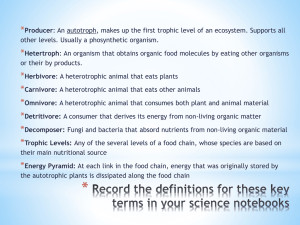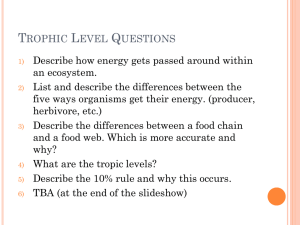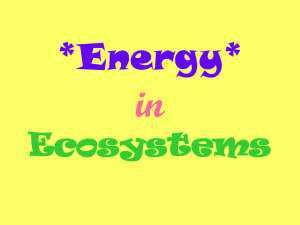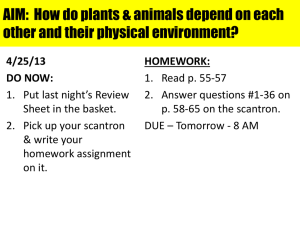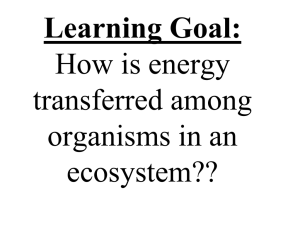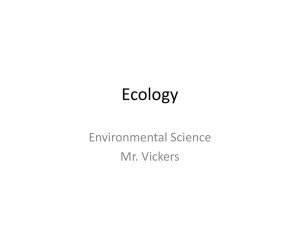Roles of Energy Review Set
advertisement
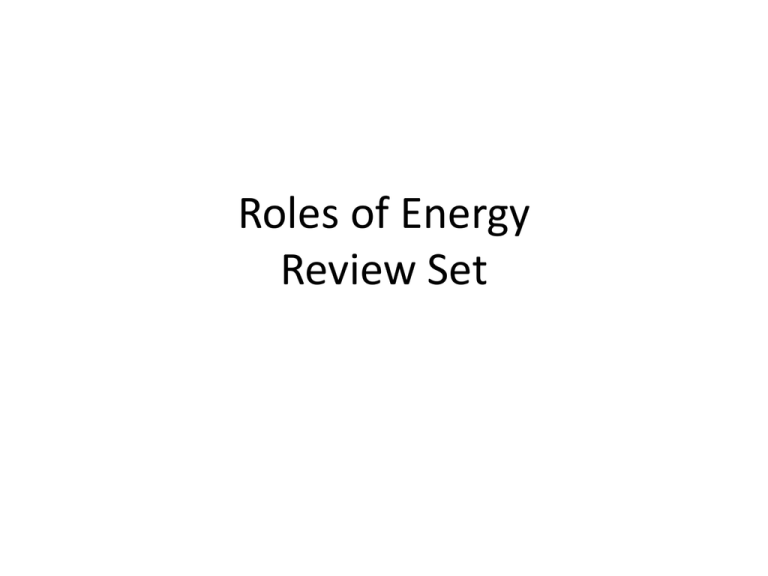
Roles of Energy Review Set • Which of the following consumer is a herbivore? • • A. cat • • B. horse • • C. human • • D. vulture • Which of the following consumer is a herbivore? • • A. cat • • B. horse • • C. human • • D. vulture • A student is identifying food chains in an ecosystem. Which of the following organisms might be a tertiary consumer? • • A. Frog • • B. redwood tree • C. great white shark • D. athlete’s foot fungus • A student is identifying food chains in an ecosystem. Which of the following organisms might be a tertiary consumer? • • A. Frog • • B. redwood tree • C. great white shark • D. athlete’s foot fungus • Two types of global food webs show the feeding relationships of organisms. What distinguishes one type of global web from the other? • A. whether the producers are located on land or in water • B. whether or not the food web includes tertiary consumers • C. whether the web includes animals that migrate during the year • D. whether the ecosystem described by the web is localized or very broad • Two types of global food webs show the feeding relationships of organisms. What distinguishes one type of global web from the other? • A. whether the producers are located on land or in water • B. whether or not the food web includes tertiary consumers • C. whether the web includes animals that migrate during the year • D. whether the ecosystem described by the web is localized or very broad • All organisms must obtain energy from their environment. Every organism needs this energy in order to grow and reproduce. How do producers obtain energy? • A. They obtain energy by eating plants, bacteria, and algae. • B. They extract chemical energy from decaying organic matter. • C. They extract energy from the chemicals in soil, air, and water. • D. They capture energy from sunlight and manufacture their own food. • All organisms must obtain energy from their environment. Every organism needs this energy in order to grow and reproduce. How do producers obtain energy? • A. They obtain energy by eating plants, bacteria, and algae. • B. They extract chemical energy from decaying organic matter. • C. They extract energy from the chemicals in soil, air, and water. • D. They capture energy from sunlight and manufacture their own food. • Why are decomposers an essential part of a healthy ecosystem? • • A. Decomposers are a necessary part of the diet of most consumers. • B.Decomposers convert plant material into a form that primary consumers can use. • Decomposers make resources available to producers by breaking down waste materials. • • Decomposers extract energy from sunlight as they break down plant materials, adding returning energy to the system. • Why are decomposers an essential part of a healthy ecosystem? • • A. Decomposers are a necessary part of the diet of most consumers. • B.Decomposers convert plant material into a form that primary consumers can use. • C. Decomposers make resources available to producers by breaking down waste materials. • • D. Decomposers extract energy from sunlight as they break down plant materials, adding returning energy to the system. • Energy transfer • A. Increases by 10% as the trophic levels move up the food chain. • B. Remains constant regardless of moving up or down on the food chain. • C. Varies with the ecosystem it is in. • D. Loses about 10% as the trophic levels move up the food chain. • Energy transfer • A. Increases by 10% as the trophic levels move up the food chain. • B. Remains constant regardless of moving up or down on the food chain. • C. Varies with the ecosystem it is in. • D. Loses about 10% as the trophic levels move up the food chain. A food web A. Shows all choices of food that predators can choose. B. Shows the feeding relationships among organisms in an ecosystem. C. Is the path of energy transfer from producers to consumers. D. Shows where all organisms get their nutrients from. A food web A. Shows all choices of food that predators can choose. B. Shows the feeding relationships among organisms in an ecosystem. C. Is the path of energy transfer from producers to consumers. D. Shows where all organisms get their nutrients from. A consumer is A. An organism that eats other organisms. B. Eats only other animals. C. Eats other plants D. Eats both plants and animals A consumer is A. An organism that eats other organisms. B. Eats only other animals. C. Eats other plants D. Eats both plants and animals • During the 1930s, a large region of the Great Plains experienced a drought that turned grasslands into dust. How did this change most likely affect populations of insects living among the grasslands? • • A. They adapted to eat dust instead of grass. • • B. They decreased because the resources they needed were not available. • • C. They increased because other populations were eliminated from the environment. • • D.They were not affected because the size of a population cannot change over time. • • • • • • • • • During the 1930s, a large region of the Great Plains experienced a drought that turned grasslands into dust. How did this change most likely affect populations of insects living among the grasslands? A. They adapted to eat dust instead of grass. B. They decreased because the resources they needed were not available. C. They increased because other populations were eliminated from the environment. D.They were not affected because the size of a population cannot change over time. A producer A. Is also called a omnivore B. Eats meat and plants C. Is becoming extinct in most ecosystems D. Uses energy to make food. A producer A. Is also called a omnivore B. Eats meat and plants C. Is becoming extinct in most ecosystems D. Uses energy to make food • • • • • • • • • Some consumers, such as many flying insects, need large amounts of energy to grow and move from one place to another. How do consumers get energy to function? A. Consumers obtain all of their energy by eating other organisms. B. Consumers obtain some energy from other organisms and some from sunlight. C. Consumers obtain most of their energy by absorbing it from their environments. D. Consumers convert light energy from the sun into chemical energy stored in food. • • • • • • • • • Some consumers, such as many flying insects, need large amounts of energy to grow and move from one place to another. How do consumers get energy to function? A. Consumers obtain all of their energy by eating other organisms. B. Consumers obtain some energy from other organisms and some from sunlight. C. Consumers obtain most of their energy by absorbing it from their environments. D. Consumers convert light energy from the sun into chemical energy stored in food. • Carnivores and herbivores are both consumers. Which statement best describes how they differ from one another? • A. Carnivores produce all the energy they need. • B. Carnivores eat only animals whereas herbivores eat only plants. • C. Carnivores eat living organisms whereas herbivores eat organisms that have died. • D. Carnivores obtain energy by eating food whereas herbivores obtain energy from the sum. • Carnivores and herbivores are both consumers. Which statement best describes how they differ from one another? • A. Carnivores produce all the energy they need. • B. Carnivores eat only animals whereas herbivores eat only plants. • C. Carnivores eat living organisms whereas herbivores eat organisms that have died. • D. Carnivores obtain energy by eating food whereas herbivores obtain energy from the sum. The only trophic level above a tertiary consumer is A. Primary consumer B. Quaternary consumer C. Primary producer D. Secondary consumer The only trophic level above a tertiary consumer is A. Primary consumer B. Quaternary consumer C. Primary producer D. Secondary consumer As nutritional energy passes through the food chain, energy A. Is lost B. Is gained C. Remains constant D. Increases then decreases As nutritional energy passes through the food chain, energy A. Is lost B. Is gained C. Remains constant D. Increases then decreases • A plant is • • A. an autotroph • • C. a primary producer B. a heterotroph D. A & C • A plant is • • A. an autotroph • • C. a primary producer B. a heterotroph D. A & C The lower the trophic level A. The fewer the organisms B. Numbers of organisms will remain the same C. The more the organisms D. The harder it is for survival The lower the trophic level A. The fewer the organisms B. Numbers of organisms will remain the same C. The more the organisms D. The harder it is for survival • Tertiary consumers eat • • A. primary producers consumers • • C. secondary consumers B. primary D. quaternary consumers • Tertiary consumers eat • • A. primary producers consumers • • C. secondary consumers B. primary D. Quaternary consumers • A cow is • • A. a primary consumer • • C. an herbivore B. a heterotroph D. all of the above • A cow is • • A. a primary consumer B. a heterotroph • C. an herbivore D. all of the above • Autotrophs • • A. make their own food base of the food chain • • C. are primary producers above B. are the D. all of the • Autotrophs • • A. make their own food B. are the base of • the food chain • C. are primary producers D. all of the above • Grizzly bears are classified in the order Carnivora. Their diet consists of roots, tubers, berries, nuts, fungus, insects, rodents, and fish. What ecological role best describes grizzly bears? • • A. carnivores B. omnivores • • C. herbivores D. producers • Grizzly bears are classified in the order Carnivora. Their diet consists of roots, tubers, berries, nuts, fungus, insects, rodents, and fish. What ecological role best describes grizzly bears? • • A. carnivores B. omnivores • • C. herbivores D. producers What is the primary source of energy for most ecosystems? A. Water B. Organisms beneath those on the trophic level C. Sun D. Air What is the primary source of energy for most ecosystems? A. Water B. Organisms beneath those on the trophic level C. Sun D. Air • After a mild winter and plenty of food, a deer population grew rapidly. What most likely happened to the wolf population in that same ecosystem? • A. It was unaffected. B. It grew. • C. It shrunk. D It went extinct • After a mild winter and plenty of food, a deer population grew rapidly. What most likely happened to the wolf population in that same ecosystem? • A. It was unaffected. B. It grew. • C. It shrunk. D It went extinct • A top predator • • A. has no natural enemies B. is a meat eater • C. is a heterotroph D. all of the above • A top predator • • A. has no natural enemies B. is a meat eater • C. is a heterotroph D. all of the above If a person eats a salmon (that ate smaller fish that ate algae), the person is acting as A. A primary producer B. A primary consumer C. A secondary consumer D. A tertiary consumer If a person eats a salmon (that ate smaller fish that ate algae), the person is acting as A. A primary producer B. A primary consumer C. A secondary consumer D. A tertiary consumer



